This post may contain affiliate links. Please see our disclosure policy.
This pressure canned chicken and vegetable soup is a classic, comforting base packed with tender chicken, carrots, corn, and savory broth. It’s perfect on its own or served with dumplings, rice, or noodles. A versatile and shelf-stable meal for easy weeknight dinners.
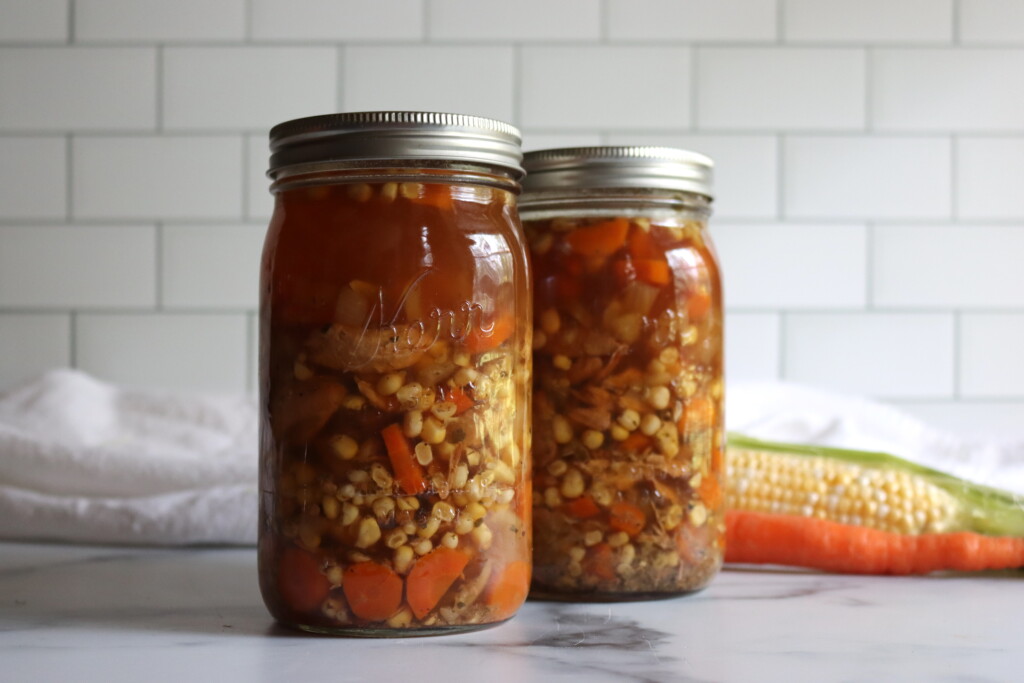
Table of Contents
This classic chicken and vegetable soup is simple, versatile, and endlessly useful. Adapted from Angi Schneider’s Pressure Canning for Beginners and Beyond, it’s a reliable base soup that can be served as-is, or customized with grains, noodles, or dumplings depending on your mood.
It’s a lighter option compared to creamy chowders or rich stews, and the flavor works well year-round. Keep a few jars on the shelf and you’ll always have a nourishing, homemade meal ready to go.
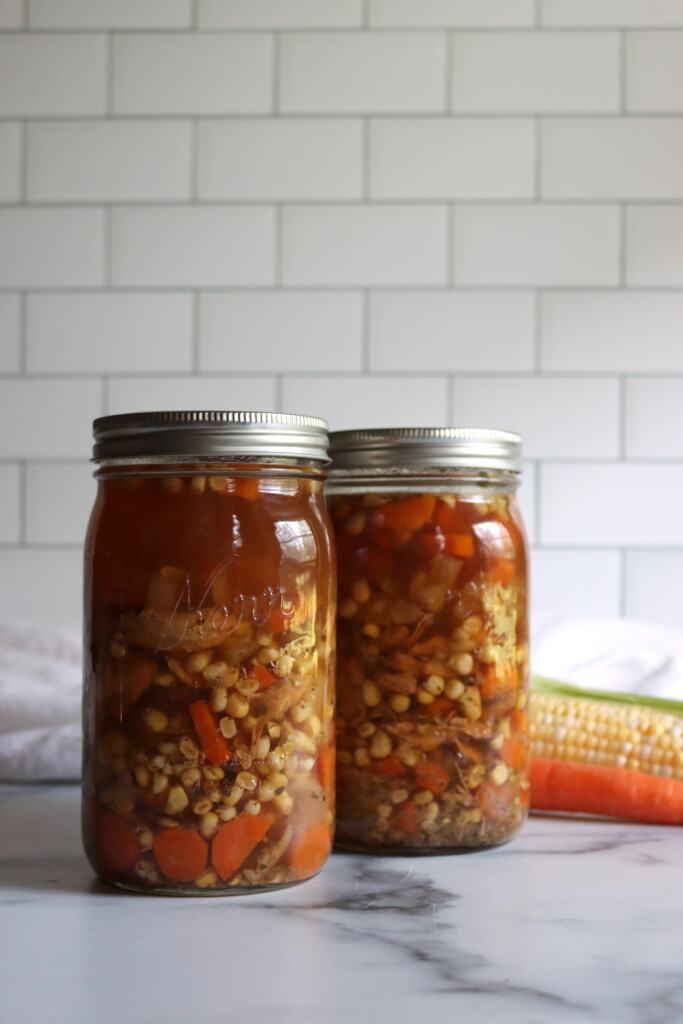
Ingredients for Chicken and Vegetable Soup
This recipe yields 4 quarts or 8 pints, making it an ideal batch size for a full canner run. Here’s what goes into each jar:
Cooked Chicken – Use shredded chicken from white or dark meat, or a mix of both. Rotisserie leftovers, baked chicken breasts, or home-cooked chicken all work here.
Chicken Broth – A rich, well-seasoned broth is key. You can use homemade or store-bought, as long as it’s unsalted or low-sodium for best control.
Vegetables – A mix of onions, carrots, and corn keeps the soup hearty but not heavy. You can use fresh or frozen corn—both work well in the canner.
Seasonings – A simple blend of salt, black pepper, dried thyme, and garlic powder gives this soup a savory backbone that complements the chicken and veggies without overpowering them.
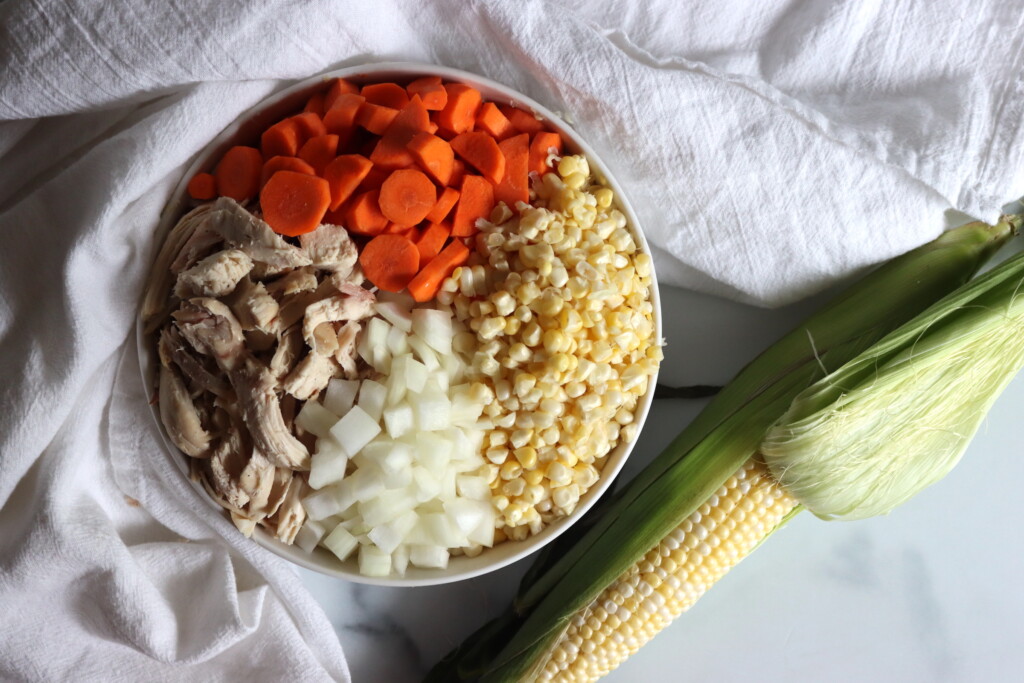
How to Make Chicken and Vegetable Soup for Canning
Start by preparing your pressure canner and sterilizing jars. Preheat the canner water to about 180°F for a hot pack.
In a large stockpot or Dutch oven, combine the cooked, shredded chicken with chicken broth, chopped onions, corn, carrots, and all seasonings. Stir to combine and bring the mixture to a boil. Once it reaches a boil, reduce the heat and simmer for 5 minutes to heat through.
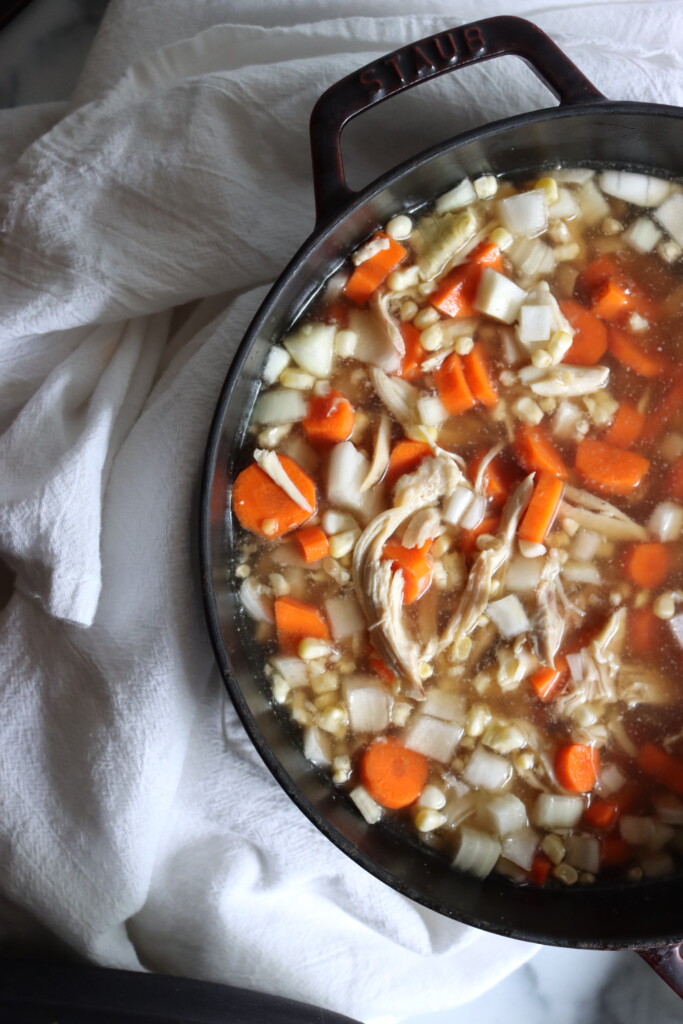
Ladle the hot soup into hot jars, leaving 1 inch of headspace. Remove air bubbles, wipe the rims with a clean cloth, and apply two-piece canning lids to fingertip tightness.
Process the jars in a pressure canner at 10 pounds pressure for weighted gauge or 11 pounds for dial gauge, adjusting for altitude. Process pints for 75 minutes and quarts for 90 minutes.
Let the canner cool naturally. Once safe to open, remove jars and let them rest undisturbed for 12–24 hours. Check seals before labeling and storing in a cool, dark place.
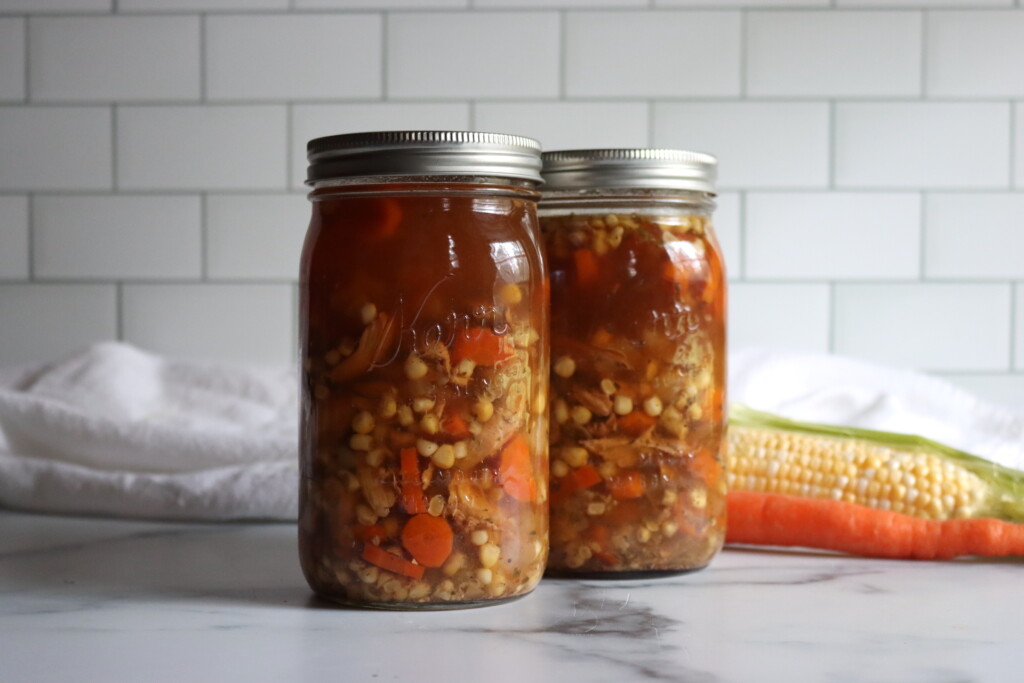
Altitude Adjustments
With pressure canning, the processing times stay the same at higher altitudes, but the pressures change. Here are the altitude adjustments for pressure canning soup:
For dial gauge pressure canners:
- 0 to 2,000 feet in elevation – 11 lbs pressure
- 2,001 to 4,000 feet in elevation – 12 lbs pressure
- 4,001 to 6,000 feet in elevation – 13 lbs pressure
- 6,001 to 8,000 feet in elevation – 14 lbs pressure
For weighted gauge pressure canners:
- 0 to 1,000 feet in elevation – 10 lbs pressure
- Above 1,000 feet – 15 lbs pressure
Serving Ideas
This soup is designed to be flexible. You can serve it just as it is, or add cooked rice, barley, or noodles when reheating to stretch it further. It also makes a perfect base for chicken and dumplings—just bring the soup to a simmer and drop in raw dumplings, cooking until tender.
For a quick and cozy meal, heat and serve with a slice of sourdough or a side of biscuits. It’s comforting, simple, and endlessly customizable.
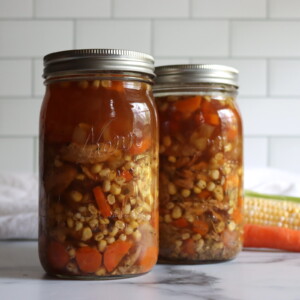
Chicken Vegetable Soup
Equipment
Ingredients
- 1 1/2 lb cooked chicken, white or dark meat, shredded
- 6 cups chicken broth
- 1 cup onions, chopped
- 1 cup corn kernels, fresh or frozen
- 2 cups carrots, peeled and diced
- 2 tsp canning salt
- 1 tsp black pepper
- 1 tsp dried thyme
- 1 tsp garlic powder
Instructions
- Prepare a pressure canner and jars for hot pack. Heat the canner water to about 180°F.
- In a large stockpot or Dutch oven, combine the chicken, broth, onions, corn, carrots, salt, pepper, thyme, and garlic powder. Stir well.
- Bring the mixture to a boil, then reduce to a simmer and cook for 5 minutes to heat through.
- Ladle the hot soup into clean, hot jars, leaving 1 inch of headspace.
- Remove air bubbles, adjust headspace, wipe rims, and apply two-piece lids and rings.
- Process in a pressure canner at 10 lbs pressure (weighted gauge) or 11 lbs (dial gauge), adjusting for altitude.
- Process pints for 75 minutes and quarts for 90 minutes.
- Let the canner cool naturally, then remove jars and allow to rest undisturbed for 12–24 hours. Check seals before storing.
Notes
Canning Safety Note
This soup contains low-acid ingredients and must be pressure canned. Never use a water bath for this recipe. Always follow tested processing times and adjust pressure for your elevation.Altitude Adjustments
Adjust your pressure based on elevation: Dial Gauge Canners- 0–2,000 ft: 11 lbs
- 2,001–4,000 ft: 12 lbs
- 4,001–6,000 ft: 13 lbs
- 6,001–8,000 ft: 14 lbs
- 0–1,000 ft: 10 lbs
- Above 1,000 ft: 15 lbs
Serving Suggestions
Serve as-is, or stir in cooked noodles, rice, or barley before serving. For chicken and dumplings, heat the soup and drop in raw dumplings to cook in the broth. Top with fresh herbs, a sprinkle of black pepper, or enjoy with a biscuit or slice of bread.Nutrition
Nutrition information is automatically calculated, so should only be used as an approximation.
Chicken Canning Recipes
Looking for more simple, wholesome chicken pressure canning recipes?
This Chicken and Vegetable Soup is a great base for adding grains or dumplings, but if you’re after a creamy classic, try Chicken and Corn Chowder, finished with cream at serving.
Canning Chicken Pot Pie Filling is another cozy option with chicken, peas, and carrots ready for baking.
Spice things up with Thai Red Curry Chicken, packed with bold flavors and easy to serve over rice.For a comforting cold-weather staple, you can’t go wrong with Canning Chicken Soup, a timeless favorite.
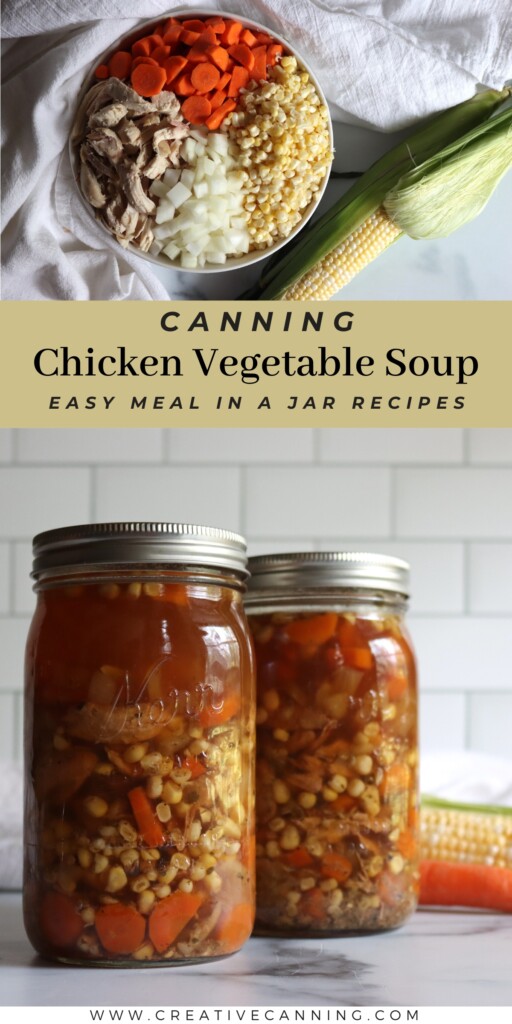
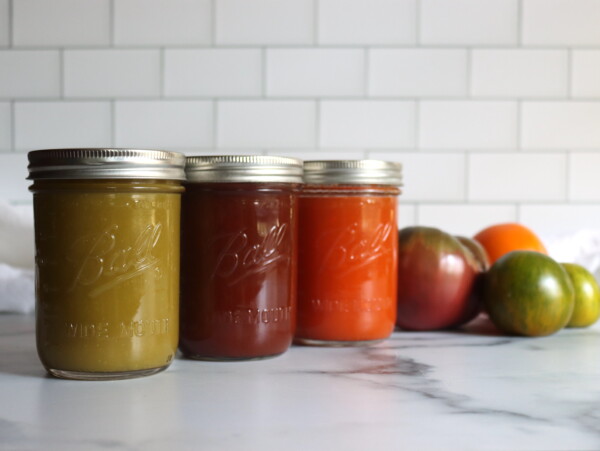
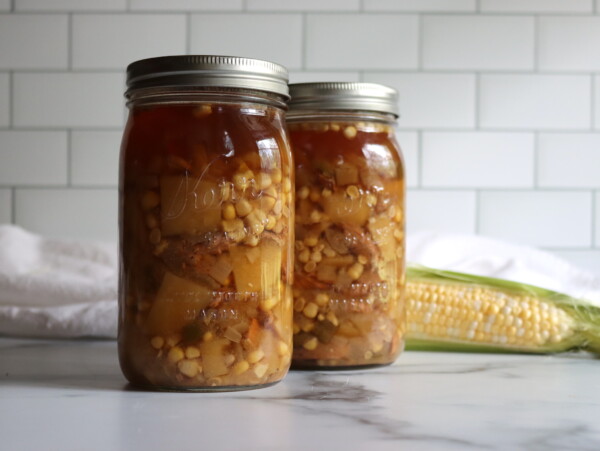
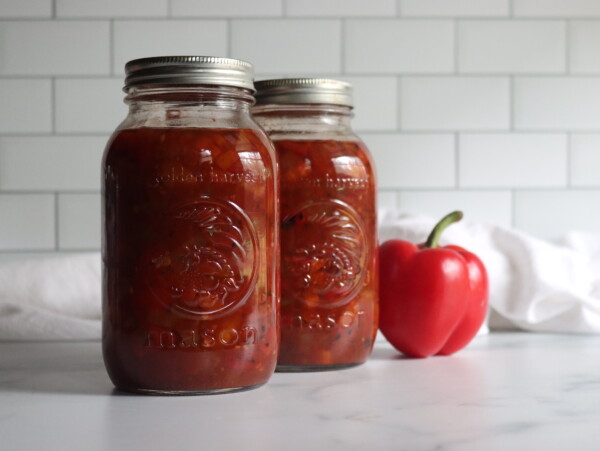

A bit heartier than simple chicken soup, this one’s just as easy to make!
I would can a variation on this for my elderly parents. They did not like corn in soups, so I’d substitute celery for the corn. Since dad was on a low salt diet, I’d also skip the salt. They loved it….. 🙂